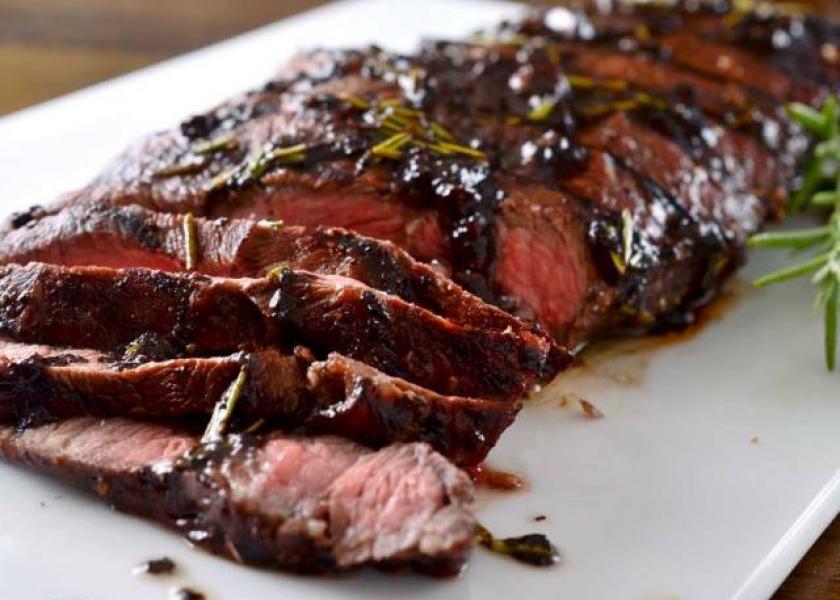Beef: It's What's for Dinner Again

Beef is making a comeback.
After decades of diners shunning steaks and burgers for healthier protein options such as chicken and turkey, Americans will eat an estimated 54.3 pounds of the red meat this year -- the first increase since 2006 and almost half a pound more per person than in 2015, according to data from the U.S. Department of Agriculture.
Cheaper prices are spurring discounts and new menu items at restaurant chains, including Chili’s and Wendy’s Co. Protein-centric diets such as the Paleolithic, or Paleo, and Autoimmune Protocol that eliminate grains and sugar also are fueling the shift.
“Certainly there’s been a big push towards eating more meat and more meat proteins,” said Altin Kalo, an analyst at Steiner Consulting Group, an economic and commodity-trading adviser. Increased beef production also is contributing to the rise, he noted.
“Suddenly there is this extra supply of meat,” Kalo said. “You’re going to have to somehow consume all of it.”
At the start of 2014, U.S. cattle supplies were the lowest in more than six decades after years of drought in the South and Southwest. The shortage sent beef prices surging to records. Since then, ranchers have been able to raise more cattle, and the latest USDA numbers show herds at a five-year high.
That’s helping to drive prices down. In February, a pound of uncooked ground beef retailed for $4.38, about 7 percent below a year ago, according to data from the Bureau of Labor Statistics.
Even with the lower cost, beef consumption is well below historic levels: Americans ate as much as 94.3 pounds per person in 1976. Chicken has outpaced it since the early 1990s, and diners are projected to eat more than twice as much chicken, turkey and pork this year.
Restaurant chains are trying to shift their preferences, using the cheaper prices to promote special menu items. Some Texas Roadhouse Inc. locations are advertising a “Wild West Wednesdays” special with an 8-ounce sirloin steak and two side dishes for $9.99. The Louisville, Kentucky-based company has said it expects to pay 1 percent to 2 percent less this year for food than in 2015, mainly because of lower beef costs.
Red Meat Production Up 5%
Want more video news? Watch it on AgDay.
4-for-$4 Promotion
Wendy’s is selling more beef after starting a 4-for-$4 promotion, which includes a cheeseburger, in October. It also has revamped its Dave’s hamburgers with a new bakery-style bun and bolder-flavored mayo. Eleven million more customers visited one of its restaurants in the fourth quarter compared with a year ago, according to Kurt Kane, chief concept and marketing officer for the Dublin, Ohio-based company.
Consumers are drawn by discounts, and the lower beef costs help make them possible, Kane said. Promotions also have played a large role in boosting beef sales, he added.
“People have really responded well and are not buying just more of our Dave’s burgers, but across our whole line,” he said.
Fancier eateries are coming up with even more exotic variations. The Burger of the Month for March at Kuma’s Corner, with restaurants in Chicago and Indianapolis, is a 10-ounce beef patty with deep-fried mozzarella sticks, house-made puttanesca sauce and hot capicola -- an Italian pork cold cut -- “topped with a basil chiffonade,” according to its website. Another burger comes with pancetta, brie and a bourbon-poached pear.
Chili’s is offering less-expensive beef in its new line of steaks, which are part of its 2-for-$20 dinners. The casual-dining chain, owned by Brinker International Inc., now has a citrus-chili avocado sirloin, as well as a steak topped with honey-chipotle shrimp.
So far customers like the new sirloins, which took about a year to develop, said Edithann Ramey, vice president of marketing.
“Beef is going to continue to be a big part of Americans’ diets,” she said.







